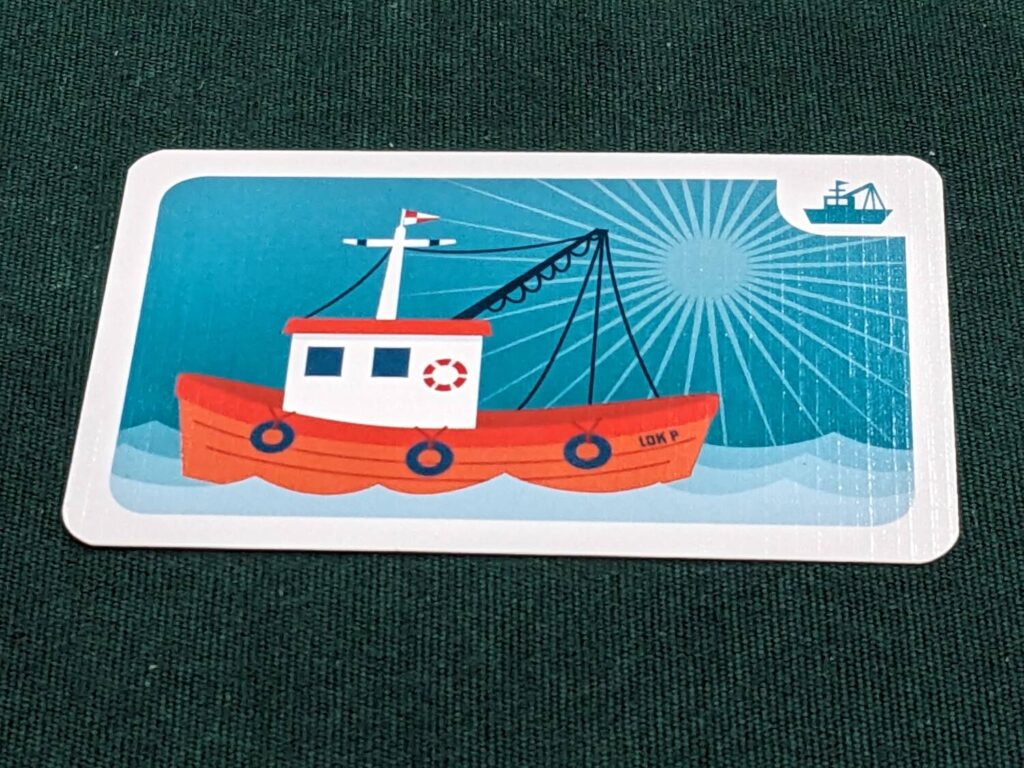Disclosure: Meeple Mountain received a free copy of this product in exchange for an honest, unbiased review. This review is not intended to be an endorsement.
I’ll play any game by the prolific designer Friedemann Friese, the man behind hits such as Power Grid, Fancy Feathers and Findorff. That’s because he is always trying to do something different, as opposed to rehashing some of the things that worked in past designs. I wouldn’t call him a maverick, but I would call him a guy who seems to have a flair for the dramatic, right down to the green hair he sports whenever I see him running around at conventions.
Friese’s latest design is a card game called Fishing (or Fischen, in German), published by his 2-F Spiele label. The best way I can describe Fishing is to call it a trick-taking game, with elements of deckbuilding baked into the design. Over the course of eight rounds, the player who scores the most points wins—earned with a simple metric of one point per card won at the end of each round.
There’s a lot more to it than that, some of which worked well, some of which did not. I tried this game twice with three players—using a different audience for each play—then once at five, with a group separate from the first two groups. Then, I took the extreme step of asking other peers in my space for their opinions of the game. Opinions varied so widely that multiple people called it the best game they have played this year, and two others in my local groups thought it was so bad that they wanted to stop before the game was even over.
Let’s give Fishing this much—it is going to trigger a response, one way or the other. That’s because the game has so many swings, even within each round: some rounds were dry toast, while others were chaotic. Sometimes, players thought they were putting a strategy into place…until they were not. Others who took a more tactical approach to the deckbuilding elements were surprised to see long-term strategies develop, particularly when it came to planning for the eighth and final round of each game.
I landed somewhere in the middle. There is an ocean of trick-takers hitting the market right now, and I think Fishing speaks to a specific audience: those who are willing to play a longer card game than normal, and those who are willing to invest in multiple plays. If you are looking for a home run out of the box, look elsewhere. But for those willing to socialize this game with the same group across a half-dozen plays or more, Fishing is absolutely worth a look.

Fisherperson
Fishing is a 3-5 player card game. Players are dealt a hand of cards from a mix of four suits—purple, red, teal, and yellow, with a value range of 1-10. In the game’s first round, Fishing is a standard “must follow” trick-taking game with no trump suit. The highest card in the led suit wins each of the tricks in that round. Acquired tricks are placed on top of a card featuring a cute image of a fisherman (maybe it’s a fisherperson?), then players score one point for each card they have won when players have used all their cards.
At this point, the game of Fishing begins for real.
For the next seven rounds, players set aside any cards won during the previous round. Then, they look at the pile of any cards currently on top of their personal fishing boat card and draw cards from that stack until they reach the draw limit of the upcoming round, which scales based on player count. (Between the first and second rounds, there are no cards on the fishing boat yet.)
The cards on the fishing boat are important to call out here as they are a mix of the cards you’ve won previously. Some might be great. Others are definitely terrible, because players sometimes toss less-desirable cards into a trick when they know they can’t (or don’t want to) win, just like in a normal trick-taking game. But for a future round, those cards are going to be your hand, and winning tricks with those not-so-great cards is gonna be tough.
If a player can’t draw enough cards to form a full hand from their fishing boat cards, they shuffle cards won from the previous round—the ones that were on the cute fisherperson—then continue to deal themselves enough cards to form a hand limit aligned with the current round, based on player count.

And here’s where the game gets juicy. Anyone who cannot fill their entire hand with cards from their fishing boat, then their fisherperson, gets to draw from the “Ocean Stack.” The Ocean Stack is like the Glengarry leads from the play Glengarry Glen Ross. Simply put, the Ocean Stack is where all the great cards are. You only get them if you require new cards, which should help seed your hand with the best cards available.
During setup, this special deck of Ocean Stack cards is built using a star system…the best cards have five stars, and do some wacky things. The five-star cards are placed at the bottom of the Ocean Stack, with cards ranging from four stars, then three, two, and one star placed on top. The entire stack of 60 Ocean Stack cards—these, unlike the starting cards, are not scaled by player count, an issue we will come back to—are only used when a player is short on cards.
So, let’s say my buddy Dale won the majority of tricks in the first round, while Selma and I won very few tricks in the first round. Dale just scored a lot of points, but for the second round, his cards probably won’t be as good as the ones Selma and I are about to draw. That’s because we have cards that are markedly better than the starting cards. Some of the new cards are green, the trump suit in Fishing that is not available in round one. Some have cool powers. Some are strictly higher numbers than the starting cards. So, I might get a 12 teal through the Ocean Stack, making it the highest card now available in the game.
This could give you a chance to steal some great cards from Dale, who unknowingly plays his 10 teal thinking that it will sweep another round, only to find me taking that trick with the 12 teal. These kinds of surprises will pop up a lot in the first or second play, leading to a lot of fun moments. Some players—and I included myself in this during my first two plays—will mistakenly think that they can turn Fishing into a strategy game without knowing what is possible, where you can selectively find ways to lose enough tricks to have access to the Ocean Stack at just the right time.
But my findings suggest that this is much harder in reality. In fact, I found that the winning player usually did their best work by winning a lot of cards every round, not just trying to swing the game in one direction or the other with a massive round, then a quiet round.
I wasn’t sure that was quite as fun. One thing I was sure about across all three of my plays—eight rounds is way too long for a trick-taking game. In a year where you can get a lot of bang for your buck by finding a trick-taker that wraps up in 30 minutes, one of my Fishing games took just shy of an hour. With slower players, that is definitely a possibility, particularly at the maximum player count.

A Slow Burn
Fishing is the kind of game that rewards an investment.
Almost no one who joined me for local plays enjoyed the first game if they didn’t win (remember, winner’s bias is real). But that was also due to the fact that most players did not catch on to the importance of winning rounds with just the right number of cards. Players could win a trick or two each round and still inject better cards into their engine.
In many ways, Fishing is a deckbuilding game, with elements that push players to “banish” or trash cards from their deck by tossing the less-desirable cards into tricks won by opponents. This provides a fresh drip that can compete, but it also allows a player to specialize if they want to concentrate their firepower in one area (heavy on trumps, heavy on one specific color, heavy on cards that have powers, etc.).
Most of this comes when a player has seen the game’s arc more than once. The only person who joined me for plays that had seen the game more than once talked a lot about that during a three-player game. He had an easier time understanding how to play rounds six and seven so that he could math out the possibilities for a big run at the end.
Flipping that idea on its head, then, means that Fishing wasn’t as rewarding for players who saw it once and knew they wouldn’t see it again. Even seeing the game three times hasn’t unlocked the joy for me (at least, not yet), and it’s a game that provides a noticeable advantage to the player who has seen the game the most.

Fishing also strikes me as a game that is built for core hobbyists and not casual players. Fishing is one of the few card games I won’t be showing off during the family gatherings over the holidays this year. There are simply too many rules for my non-game-playing uncle. Like games such as Seers Catalog, Fishing exists to deepen the available pool of card games for gamers, and that’s totally fine. Just don’t expect Fishing to land well with your “muggle” friends.
As a production, I loved the bright colors used on the cards and the iconography was easy to follow. Some players took issue with the artwork (particularly the five-tentacled octopus, the suit on the red cards), but also like Seers Catalog, I was too busy playing the cards to notice the lack of tentacles.
My only issue with the game’s rules was the way that Ocean Stack cards are distributed. It wasn’t clear to me why players who needed the most cards from the juicy deck had to draw those first, before an opponent who might get cards from the higher star categories as a result. I’m not sure how I would best change or house rule this—maybe the player with the highest score pulls from the Ocean Stack first, as a catch-up mechanism?—but this did create questions during my plays.
Fishing does a lot of interesting and unique things in terms of its mechanics. I’m not sure this is a voyage I will take again, but I will always try a new Friedemann Friese game!











Add Comment